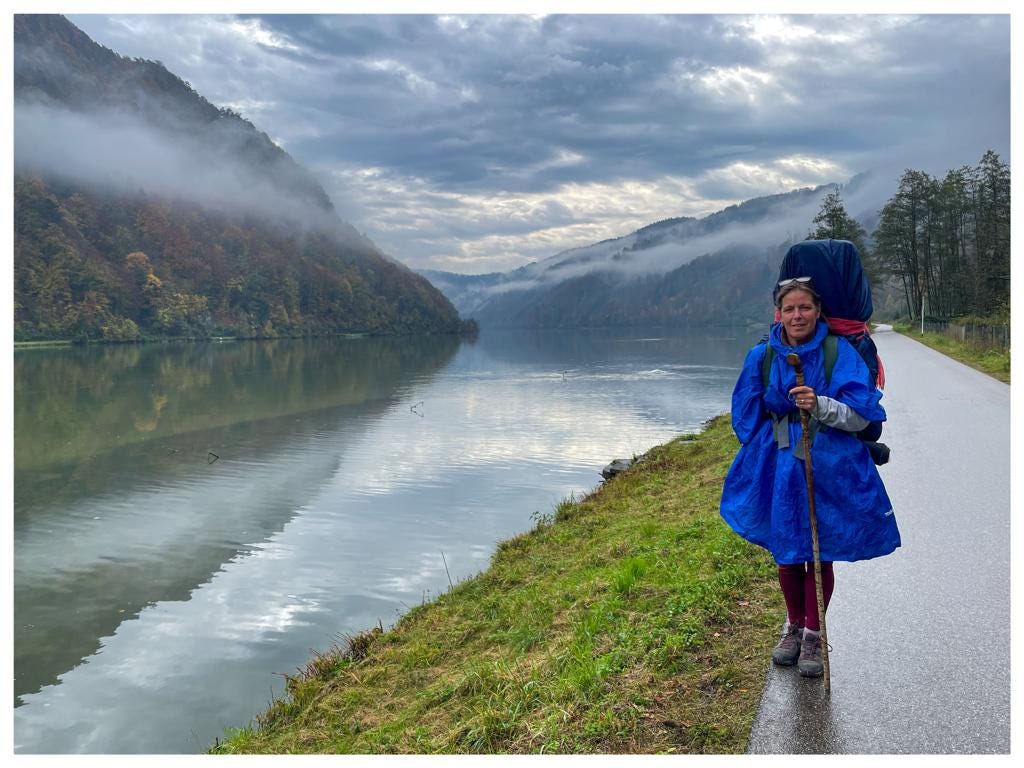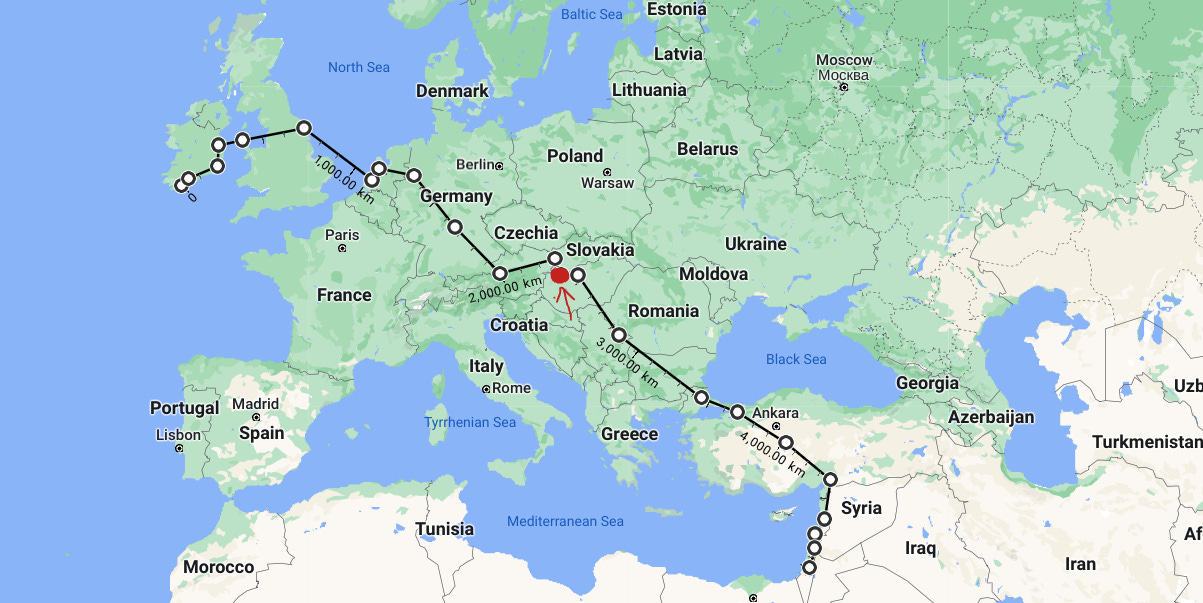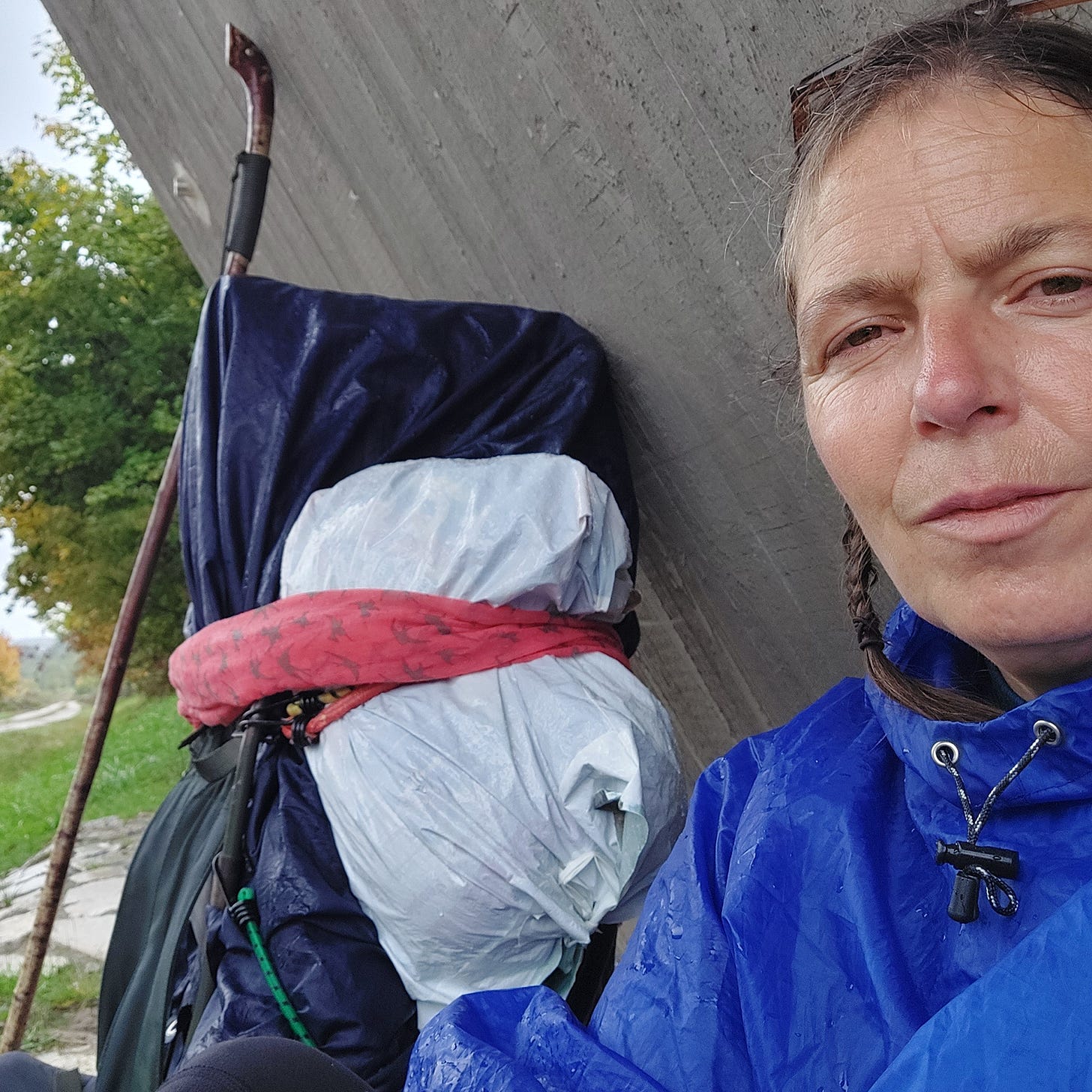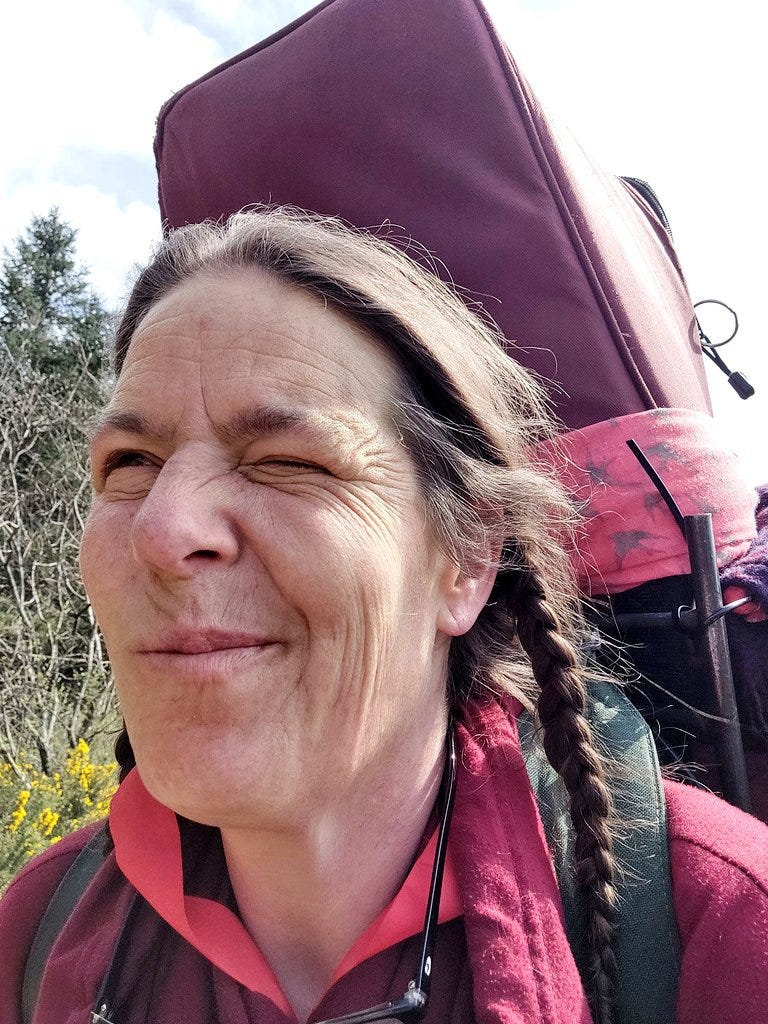Lessons from the road
Clonakilty woman Anja Bakker and her trusty harp Seán are almost halfway to Jerusalem on their 7,000km pilgrimage of a lifetime. She tells Tripe + Drisheen what she's learned on her journey so far.

“I have a thing about borders: every time I approach a border, I feel the line in the sand.”
Anja Bakker is sitting in a Steiner-Waldorf school in Győr in the north west of Hungary. She crossed over the border from Slovakia the day before our interview. She had walked in Slovakia for just two days, having crossed Austria before that.
After our interview, Anja will suffer a severe bout of food poisoning and have to lay low for a couple of days, a frustrating set-back but one that she takes in her stride.
As a pilgrim on a 7,000km journey by foot from Clonakilty to Jerusalem, taking things in her stride is pretty much what Anja does these days.
But the food poisoning and the delay is still ahead of her: from where we’re sitting, she looks happy and relaxed and very much like a Medieval traveller, draped in a thick grey wool wrap and with several talismans hung around her neck. She shows them off to me on the laptop camera: “I am the best protected pilgrim around,” she says with a laugh.
“I have my Camino shell, in Frankfurt I was given this stone cross, and then another, and I was given runes for protection, and a whole rake of Holy Mary medals,” she says. “And I already have my first Turkish eye of Fatima.”

She has been walking for eight months now, and is in her seventh country.
Having launched a crowd-funding campaign to part-fund her journey which has raised just under €7,000 so far, she set off from her West Cork home on April 2.
The 53-year-old musician is walking with a 20kg pack: Seán the harp, plus her own bedding and personal effects. Anja is nearly halfway, but some of the toughest terrain and most geo-politically unstable situations are still ahead of her.
And so, the first and most obvious question for her is why on earth she’s walking to Jerusalem with a harp on her back.
“Well, it’s become very layered,” she says with a smile.
The Holy Trinity
“It starts out with an angry woman at forty, with loads of chips on my shoulders, loads of judgements about my family, about who I am and what I want. I needed time, and I wanted to go for a walk.”
She first set off and walked from Clonakilty to Santiago in Northern Spain, along the ancient and famous Camino pilgrimage route, in 2010. It was in the wake of the Ryan and Murphy reports into sexual abuse within the Irish church.
“For me personally, that brought up a lot of things, stuff that had happened in my family,” she says. “My mother was an abuse victim. I just felt overwhelmed.”
Anja had studied recorder in Cork School of Music and had an interest in Early Music. The decision to carry her harp with her was inspired by the wanderings of medieval troubadour harpers.
“I thought, I’ll be on the route of all these medieval stories and I’ll be the troubadour. I’ll become a pilgrim that has something to offer,” she says. “I’m there to take as well of course, to receive all those gifts that the road gives us, but I also have something to give in return.”
Sean became an intermediary, music the key to unlocking connections along the way; Anja played wherever she went, often, like her predecessors centuries earlier, offered free lodgings or meals in return for the gift of her playing.
The walking bug, and more specifically, the pilgrimage bug, bit hard. In 2018, she again set off, this time on the Via Francigena to Rome.
It became evident that she was going to try to complete the Holy Trinity of Santiago, Rome and Jerusalem.
“I want to be the woman who is the first in history to carry a harp to all those three places,” she says. But it’s more than a personal challenge: pilgrimage, whether you’re religious or not, is such a timeless human practice, that whether what you are seeking is answers or adventure or simply some peace, it’s all to be found there.
Whether we can see it or not, our modern European lives have become increasingly narrow and restrictive: the path Anja is forging is one of freedom and that doesn’t come without challenges.
“Modern society really struggles with what is really important, what is the right thing to do with a life,” she says. “And I think we’re getting it all wrong. The right thing for me to do is go out there and ask, ‘show me what it’s all about.’ Because I can’t see it: I’ve lost track of what is important.”
“And what I understand now is that sometimes we can’t see what’s important until we’ve seen it many times. I know the answer is right in front of my face, but I can’t see it yet. So I made myself the promise that I will go to the end.”
“I made myself a little magic: every morning I get up, I go, open heart, open mind. I say to myself, ‘if it is important, open the road before me and I will walk it. Here I am.’”
A disclosure in the interests of transparency: I know a very little of what Anja is talking about because I have done a pilgrimage myself. When my kids were eight and 13, we walked the lesser-known Camino path of the Caminho Portugues, 600km from Lisbon to Santiago. It was the trip of a lifetime and I made a documentary about it which you can hear here:
The road so far
Ahead of her, Anja faces choices. Winter is closing in; it’s currently between 0°C and 3°C in the day where she is, and more cold is coming. She’s torn between choosing a route to Belgrade in Serbia and onwards through Kosovo and then through Greece to Turkey and staying inland and crossing Bulgaria and Romania. Greece is lower down and milder, but, as she puts it, “the Serbians and the Kosovans seem to be rattling right now.”
She accepts that she may have to rest up for a bit if the weather gets too cold. Either route is going to take her through Turkey eventually, across the Bosphorus. And then, Syria and Lebanon.
Ironically, some of the biggest challenges she has found in finding safe routes so far were shortly after setting off in Ireland, though.
“I want to make the point that we have a lot of work to do on walking in Ireland,” she says. “We don’t have roads. I contacted the Hikers in Ireland Facebook page on how to get from Clonakilty to Dublin and they were all going, ‘go by car to a trailhead and walk from there,’ and I was saying, ‘no, I want to walk from my front door. How do I do that without endangering myself?’ This is something we really need to start talking about: that everyone has the right to walk out of their front door. This should be a given.”
Anja walked on secondary roads from Clonakilty to Dunmanway, and then inland through the Gaeltacht. At Clonmel, she took a lift she was offered to Waterford (“I walked around Waterford a lot to make up for it,” she tells me) and then took the Barrow Way and canal tow paths to Dublin.
Blisters and bereavement
She’d never had blisters on previous trips, but this spring, she experienced them with a vengeance.
“The first few weeks in Ireland, I had the wrong pair of shoes. I had never had blisters before and it really got into my head and I struggled; I really thought after three weeks I was going to go home.”
Crossing England, she left Hull for Rotterdam, and then her pilgrimage took a personal turn when she walked to Amsterdam, where she grew up. “My father died in 2019 just after I came back from Rome, so I wanted to pay my respects I suppose,” she says.
In August of this year, Anja’s mother died. Reluctant to leave her journey, she flew home to Ireland: “It was a horrible feeling to come off the road, but I had to go pay my respects. But I needed to get back, as soon as possible, before I lost momentum.”
Slow and steady wins the race
Carrying Sean may be her inter-cultural calling card and sometimes her meal ticket, but it’s also a burden: her 20kg pack becomes a strain. But she says she’s “in pretty good nick, actually.”
“My knees are fine and my ankles are fine, but my hips are a weak point. When I did the trip to Rome I did it in five months and I pushed really hard and it was too much for my body and I couldn't move for about three months afterwards. So I promised myself that I would allow myself rest. When I get overwhelmed, I just stop.”
She might put away 20km or even 25km a day, but that is the upper limit of what she is willing to do these days; she likes to stop when she still feels that there are some reserves left. If she’s couch-surfing, she might ask to stay two nights instead of one and above all, she doesn’t push herself.
“If there’s like-minded people, forget about walking, I take the rest of the day off,” she says.
“This is such a big trip, a monster of a thing. I’m never going to do this again and I’m never going to meet these people again. It’s really intense, but this is my one chance to have that intensity for my entire life. So, easy does it.”
“I’m 53; I don’t need to be a hero, I just need to arrive.”
While she originally thought she could do the entire journey to Jerusalem in one year, now, she’s less fixed on this time frame and says she’d be happy with 18 months.
Religiosity

Having begun her trilogy of pilgrimages in a state of rage against the abuses within the Catholic church, and being single mother and a firm agnostic to boot, Anja has nevertheless been finding herself reliant on the hospitality of religious orders - nuns who hear she’s on pilgrimage and offer food and lodgings, lay people of faith who do the same.
“I’ve been to more masses on this trip than ever before in my life,” she jokes. “This pilgrimage is not the well-served Camino, and you need help and a community in order to do it, and the only community available to me is the Christian community.”
“I don’t lie about anything: I always say, I don’t know if I believe in anything, I have more questions than answers and you probably don’t like me because I did everything that you didn’t want me to do: I had a child, I didn’t get married, and I had loads of lovers. What are they going to say? Oh, you shouldn’t have done that.”
In broader terms, though, what the road teaches you - gratitude, humility, the unifying truths of being a human - are spiritually aligned with some of the underlying tenets of the Christian ethos, she says.
Lessons in gratitude
“This is the essence of life, isn’t it? She says with a big grin. “Clean feet and a bit of food and a mattress that is not too hard and not too soft.”
Anja’s route is going to take her through Syria and Lebanon, through the still-disputed terrain of Jerusalem itself, a holy city for three world religions which is the source of Palestinian-Israeli conflict.
While the motives for her pilgrimage are not overtly political, she does have a very specific outlook on what it means for people to move freely and under their own steam, to traverse routes that are millennia old: she thinks it’s increasingly important for people to recognise what Fortress Europe is becoming.
“We are building walls around Europe,” she says. “The fences are going up, and we’re locking ourselves in. We need to go out into that world and break all of that down again. That is what freedom is. Otherwise, we can’t take these stories back and to remember our connections.”
“There is a big thing in there about freedom: the way Europe has developed, we believe we can choose anything but I don’t think it’s true; we believe we can buy freedom, buy happiness. Happiness is in living your life, freedom is in making choices to do things differently.”
Getting out of your own comfort zone and meeting your own prejudices and uncertainties are the path to this knowledge, she says.
“I had it walking into the Eastern Bloc countries: the prejudice, ‘oh, I don’t speak the language, they're so different.’ Then you’re sitting at a table with someone and you have your hands and twenty words of English and four words of Russian, and we find out we’re all the same. We all love our kids and want a better world.”
Looking forward to the end of the road
The strangest thing about a pilgrimage, or any big long slow adventure, is that you leave the road eventually, but the road never ever leaves you.
Ending a pilgrimage can be a strange experience, emotionally. Does Anja look forward to the end of the road, in Jerusalem? What does she think it will be like, and how will she move on from this life-defining experience? Will she ever be able to stop her pilgrimage?
The end seems far away to her, and she has trepidation about the road ahead.
“This monster is so big that I honestly can’t see how the end is possible,” she says. “It’s so complicated, and I need so much help, and it covers so many cultures. I don’t know if it’s possible, unless I can rely on this energy that seems to come over time, that we create by our movement.”
“I will get there, but I’m trying not to think too far into the future. I’m trying to think only three days ahead: from here to Budapest is enough. I know Jerusalem is the end. But then what?”
Anja gets a speculative look on her face. “I’ve already decided that I’m not flying home, that I will leave Jerusalem by boat and go to Cyprus. But then things get complicated. Because I’m thinking, I’ve never been to Greece…..and I have this invitation from the society of the Via Francigena that there is this southern route in Italy, Rome to Bari…..”
Anja Bakker’s From Here to Jerusalem GoFundMe campaign is here.





